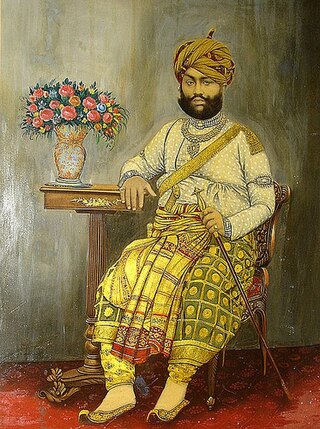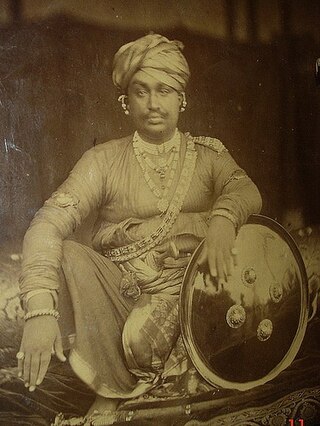Varnu is a village in Rapar Taluka in Kutch district of Gujarat, India. The village is on the west bank of Little Rann of Kutch.

Maharao Pragmalji II, (1839−1875) was the Rao of Cutch, a ruler of Jadeja dynasty who ascended the throne upon death of his father & king Rao Deshalji II on 26 July 1860 and ruled till his death on 19 December 1875.

Koteshwar is a small village and the location of an ancient Shiva temple. It located near the mouth of Kori Creek, in the west of Kutch district of Gujarat, India.

Narayan Sarovar or Narayansar is a village and place of pilgrimage for Hindus on the Kori Creek. It is located in Lakhpat taluka of Kutch district in the Indian state of Gujarat. The ancient Koteshwar temple lies 4 km away, towards the north-west. The temple is classified among the 108 Abhimana Kshethram of Vaishnavate tradition.

Maharajadhiraj Mirza Maharao Shri Deshalji II Sahib Bahadur was the Rao of Cutch belonging to Jadeja dynasty, who ascended the throne of Princely State of Cutch upon deposition of his father Bharmalji II by British. He reigned during his minority, under a Council of Regency, headed by Captain MacMurdo and composed of Jadeja chiefs.
Tera Fort is one of the many forts of Kutch, Gujarat, India. It is situated in southwestern Kutch near the village of Tera in Abdasa Taluka.

Kanthkot fort is located near Kanthkot village, Bhachau Taluka of Kutch, Gujarat.

Bhujia Fort, also spelled as Bhujiya Fort, is a fort located in the outskirts of the town of Bhuj in the district of Kutch, Gujarat, India. The fort is built atop Bhujia Hill overlooking the town.

Cutch State, also spelled Kutch or Kachchh and also historically known as the Kingdom of Kutch, was a kingdom in the Kutch region from 1147 to 1819 and a princely state under British rule from 1819 to 1947. Its territories covered the present day Kutch region of Gujarat north of the Gulf of Kutch. Bordered by Sindh in the north, Cutch State was one of the few princely states with a coastline.
Adesar is a small village in Kutch district, Gujarat, India.

Kera is a village in Bhuj Taluka of Kutch district of Gujarat, India.this historical town was ruled by the jadeja's before independence in 1947. This historical town has several places of interest; the most important part of the town's history the Darbar gadh, the ruins of an old fort and Shiva temple, and the shrine of a Muslim saint Ghulam Ali.
Pipar is a village in Lakhpat Taluka of Kutch district of Gujarat, India.
Maharajadhiraj Mirza Maharao Bharmalji II was the Rao of Cutch belonging to Rajput dynasty, who ascended the throne of Princely State of Cutch one month after the death of his father Rayadhan III.
Rao Rayadhan III was the Rao of Cutch belonging to Jadeja Rajput dynasty, who ascended the throne of Princely State of Cutch in 1778 and ruled until 1786 when he was deposed. He again ruled as titular head under council of Bar Bhayat ni Jamat from 1801 to 1813.
Bar Bhayat ni Jamat was a council of twelve members which managed Cutch State under titular kings Prithvirajji from 1786 to 1801 and under Rayadhan III from 1801 to 1813. The council was chiefly led by Fateh Muhammad during both period. The council is also known as Bar Bhayyat or Bar Bhaya.

Fateh Muhammad was a regent who administered Cutch State as a leader of Bar Bhayat ni Jamat under titular kings, Prithvirajji and Rayadhan III.

Rao Lakhpatji, also known as Lakhaji, was the Rao of Cutch belonging to Jadeja Rajput dynasty, who ruled Princely State of Cutch as a regent from 1741 to 1752. Later succeeded his father Deshalji I in 1752 and ruled until his death in 1760.
Rao Deshalji I was the Rao of Cutch belonging to Jadeja Rajput dynasty, who ruled Princely State of Cutch as a regent from 1718 1752. His son Lakhpatji confined him in 1741 and ruled as a regent until death of Deshalji in 1752.

The history of Kutch, (kachchh) a region in the extreme west of the western Indian state of Gujarat, can be traced back to prehistorical times. There are several sites related to Indus valley civilization in region and is mentioned in Hindu mythology. In historical times, Kutch is mentioned in Greek writings during Alexander. It was ruled by Menander I of Greco-Bactrian Kingdom which was overthrown by Indo-Scythians followed by Maurya Empire and Sakas. in the first century, it was under Western Satraps followed by Gupta Empire. By fifth century, Maitraka of Valabhi took over from which its close association with ruling clans of Gujarat started. Chavdas ruled the eastern and central parts by seventh century but then came under Chaulukyas by tenth century. After fall of Chaulukya, Vaghelas ruled the state. Following conquest of Sindh by Muslim rulers, Rajput Samma started moving southwards to Kutch and ruled western regions initially. By tenth century, they controlled significant area of Kutch and by thirteenth century they controlled whole of Kutch and adopted a new dynastic identity, Jadeja.

Bhujia Hill or Bhujiyo Dungar is a hill located in the outskirts of the town of Bhuj in the district of Kutch, Gujarat, India. The Bhujia Fort built on the hill overlooks the town.












